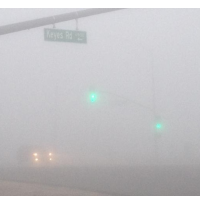Forget the Lost Snowpack; There Goes the Tule Fog!
 Tule fog in Fresno (photo: Brian Hickey, KCRA)
Tule fog in Fresno (photo: Brian Hickey, KCRA)
California is losing the leading cause of weather-related casualties on its roads, but it’s nothing to be happy about it.
The famed Tule fog of the Central Valley gives a moist cover to fruit and nut trees when it rolls in after the first big rainfall in November, and wreaks havoc on motorists for the next four months.
Not much of it rolled in this year, which is not surprising, considering the drought. But researchers at the University of California, Berkeley, say this is just an intensification of a pattern of dramatic decline in the past three decades and it bodes ill for the region’s dominant agricultural industry.
“It is jeopardizing fruit growing in California,” UC Berkeley biometeorologist and study lead author Dennis Baldocchi told the San Francisco Chronicle. “We're getting much lower yields.”
Their work, published last month in Geophysical Research Letters, reviewed 32 years of data from NASA, the National Oceanic and Atmospheric Administration and a network of UC weather stations and found a 46% decline in the number of Tule fog days. Wet years and dry years whipsawed the fog from one year to the next, but the overall pattern was decline.
But Baldocchi said rain may not be the only factor. He mentioned global warming and the abandoned practice of crop burning, which would generate fog as the air cooled afterward. The Central Valley native said you don’t really need to be a scientist to see something dramatic has happened to the area.
Much of California’s anxiety about the drought’s impact on water resources has been focused on lousy snowpack from low precipitation in the Sierra Mountains that is running about 18% of normal, but agricultural interests in the Central Valley are also losing a moist cooling system essential to their products.
The Central Valley is the nation’s largest producer of agricultural products. The California Department of Food and Agriculture (CDFA) is already projecting the drought till cost 14,500 workers their jobs while growers and farm communities suffer a $1.7-billion loss. And that’s just the early prognosis. The overpumping of limited groundwater resources―to compensate for a changing environment and poor choice of crops―and the loss of Tule fog loom large.
Soupy-thick Tule fog is a phenomenon created by rain, continued high humidity, low wind and quick cooling at night. In 2002, in two minutes, 81 cars and six tractor-trailer trucks smashed into each other while driving in zero visibility. Five years later, 108 cars and big rigs played demolition derby, leaving two dead and 100 injured.
Those all-too-common highway disasters will not be missed. But the winter chill and Tule fog―relied on by almonds, pistachios, cherries, apricots, peaches and other crops to complete their growing cycles―will. California produces 95% of the nation’s domestic fruit and nuts.
–Ken Broder
To Learn More:
As Central Valley Fog Disappears, Fruit, Nut Crops Decline (by Peter Fimrite, San Francisco Chronicle)
Now Even California's Fog Is Disappearing (by John Metcalfe, The Atlantic)
California’s Central Valley Sees Big Drop In Wintertime Fog Needed for Fruit and Nut Crops (American Geophysical Union)
Central Valley Farmers Keep Drought Losses at $1.7 Billion by Overtaxing Groundwater (by Ken Broder, AllGov California)
Winter Fog Is Decreasing in the Fruit Growing Region of the Central Valley of California (by Dennis Baldocchi and Eric Waller, Geophysical Research Letters)
- Top Stories
- Controversies
- Where is the Money Going?
- California and the Nation
- Appointments and Resignations
- Unusual News
- Latest News
- California Forbids U.S. Immigration Agents from Pretending to be Police
- California Lawmakers Urged to Strip “Self-Dealing” Tax Board of Its Duties
- Big Oil’s Grip on California
- Santa Cruz Police See Homeland Security Betrayal in Use of Gang Roundup as Cover for Immigration Raid
- Oil Companies Face Deadline to Stop Polluting California Groundwater





